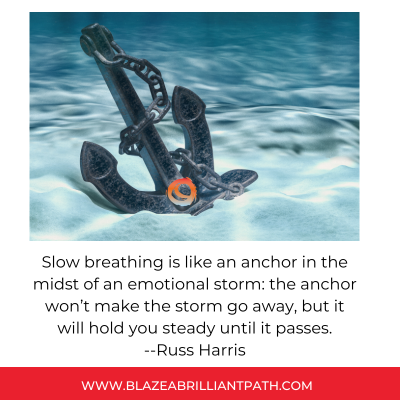You can’t put your finger on what exactly it is that makes you anxious, but the feelings of anxiety attacks are almost like a weight pulling you down, holding you back.
Maybe it’s how your partner speaks to you at home or the anxious thoughts about what could go wrong in your future. No matter what, anxiety has become a part of your life—sadly, you’ve grown accustomed to it.
At first, anxious habits and thoughts are rather exciting, especially if you’re suffering from depression. Anxious habits can act as little helpers, keeping you safe from harm by worrying about every detail until everything is covered, and there’s nothing more to worry about! (Right? No) Yet after a time, those little anxious habits become self-destructive cycles that take over your life and make you feel like a prisoner in your mind.
Anxiety can only hold you back from achieving the success you want if you let it. I intend to show you how to break free from these self-destructive anxious habits and how to remove anxiety from your life
4 Steps to Break Free of Your Anxious Habits
Step 1: The first step is to acknowledge and embrace that “anxiety happens,” don’t fight it.

You find yourself engaging in certain habits as a means of escaping this relentless feeling of anxiety, not realizing that these very habits are exacerbating your condition in the long term. It’s a vicious cycle; the more you try to escape, the more entangled you become. Fighting against your own mind is futile and will only lead you further away from peace. It’s imperative to acknowledge and embrace your anxiety. However, the approach shouldn’t be combative, as you might be inclined to do currently. Instead, the goal is to learn to coexist with your anxiety, to understand its nuances and triggers, and to develop strategies that allow you to maintain control.
I understand that this may seem counterintuitive at first glance. After all, our instincts often drive us to eliminate discomfort rather than learn to live with it. This is precisely where therapy can play a transformative role. A therapist can provide you with the tools and insights necessary to navigate the complexities of your anxiety. They can help you identify the root causes of your anxiety, understand its impact on your thoughts and behaviors, and guide you in developing healthier coping mechanisms. Through therapy, you can learn to dismantle the negative thought patterns that feed your anxiety, replacing them with more positive, constructive ones.
In embracing your anxiety, you’re not resigning yourself to a life of fear and discomfort. Instead, you’re taking the first step towards regaining control over your life. By acknowledging your anxiety, you’re allowing yourself to explore it, understand it, and ultimately, disarm it. This journey toward acceptance and understanding isn’t easy, but it’s crucial to healing and finding peace within yourself. Remember, you’re not alone in this fight; with the right support and strategies, you can navigate the complexities of anxiety and emerge stronger on the other side.
Step 2: Before an anxiety attack strikes, understand your triggers.
Anxiety is something that you deal with every day, so it’s essential to be able to manage it in healthy ways. “Managing it” is the key phrase here; you need to understand your triggers before the next anxiety attack.

If social anxiety is making it difficult for you to engage in conversation with others, or you’re having anxiety attacks whenever someone looks at you. Find ways around this so it doesn’t impact your life as much. Try taking a few deep breaths before speaking to someone new or even practicing eye contact with someone you feel safe and secure with first. The more you practice facing your anxiety, the less anxious you will become.
Every time you feel like anxiety may be coming on, try your best to recognize what triggers make you anxious. Identifying the triggers is essential to begin to take measures against them.
Living with anxiety is like being followed by a voice. It knows all your insecurities and uses them against you. It gets to the point when it’s the loudest voice in the room. The only one you can hear. –Unknown
If there is one thing I’ve learned through my experiences working with couples in the therapy room, just even hearing about how one person was stressed is enough to trigger an anxiety attack in the other partner in the pair. Because of this, I support my clients in learning how mirror neurons work and how they can enhance and complicate our relationships.
Step 3: Learning to live with the daily anxiety

Moreover, establishing a concrete, easy-to-follow routine, such as inhaling deeply for five seconds and then exhaling slowly for six seconds, can be incredibly effective. This simple yet powerful method serves as both a preventative measure and a rapid-response solution, allowing you to gain control over impending anxiety attacks by dedicating a few moments to these exercises. Within a few minutes, you’ll likely notice a significant reduction in your anxiety levels, enabling you to resume your activities with a clearer mind and a calmer disposition.
Furthermore, it’s essential to cultivate an understanding that your experiences with anxiety are not isolated incidents; countless individuals navigate similar challenges daily. Recognizing that you are part of a larger community facing these issues can bolster your confidence and motivation to pursue effective management strategies. This sense of solidarity not only diminishes feelings of isolation but also opens up avenues for sharing experiences and coping strategies with others, fostering a supportive environment for overcoming anxiety together. too.
Step 4: Find what works for YOU, and stick to it.

For some people, this might be deep breathing slowly every morning when they first wake up. For others, it could be putting their phone down on the table during dinner so they don’t feel tempted to look at social media updates constantly. Whatever it is, make sure it reduces your anxiety, even for a little bit.
I love guided meditation exercises because they help me relax when I need them most. That’s why I try to meditate every single day. For others, just taking a walk through nature or going to the gym can be all that is needed to keep anxiety at bay.
Listening to calming music, breathing techniques, and even just practicing mindfulness can be extremely helpful in preventing anxiety from taking over your life.
If you are curious about mindfulness or meditation, check out apps like Headspace or Calm.
Do whatever works for you, but find something and prioritize it; consistency will be easier!
The Sad Truth about Anxiety
Anxiety is often perceived as a lethal poison, a destructive force that we desperately seek to eliminate before it wreaks havoc on our lives. This deep-seated fear of anxiety leads many individuals, particularly those who feel ill-equipped to manage it or believe they lack the necessary control, to shy away from situations that evoke fear as a method of coping.
This avoidance behavior, while seemingly a short-term solution, often leads individuals to resort to their coping mechanisms when the intensity of anxiety becomes overwhelming. These mechanisms typically involve fleeing from the problem at hand by engaging in toxic behaviors. This approach is fundamentally unhealthy and remarkably ineffective. By not confronting fears directly, individuals miss the critical opportunity to learn and practice healthily overcoming them.
The most effective strategy for managing anxiety involves a three-step process: acknowledging its presence, willingly accepting it, and then committing to a deep dive into understanding it. This means learning as much as possible about anxiety, including its triggers and the early warning signs that signal its escalation. Such knowledge empowers an individual to anticipate and mitigate the impact of anxiety before it becomes debilitating.
Fighting anxiety head-on doesn’t mean engaging in a battle in the traditional sense. Instead, it involves finding personalized coping mechanisms that truly work for you. More importantly, it requires taking deliberate and consistent action against habits fueled by anxiety.
Taking such action not only fosters a sense of empowerment but also serves to break the vicious cycle of anxiety. It ensures that, regardless of the severity of the situation, the paralyzing grip of anxious feelings doesn’t deter you from accomplishing necessary tasks. Moreover, proactive engagement prevents anxiety from becoming an insurmountable barrier that halts all forms of productive activity.
In essence, the journey to managing anxiety is a complex and nuanced one. It requires patience, understanding, and a willingness to explore various strategies for coping. By adopting a proactive stance and committing to understanding and working through anxiety, individuals can regain control over their lives, ensuring that anxiety becomes a manageable aspect rather than an overwhelming obstacle; I can help!





